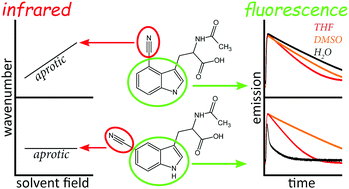Cyano-tryptophans as dual infrared and fluorescence spectroscopic labels to assess structural dynamics in proteins†
Abstract
The steady state and time-resolved fluorescence and infrared (IR) properties of 4- and 5-cyanotryptophan (CNTrp) are investigated and compared, and the tryptophan (Trp) analogs are found to be very attractive to study structural and dynamic properties of proteins. The position of the nitrile substitution as well as the solvent environment influences the spectroscopic properties (solvatochromism). Similar to native Trp, electronic (nanosecond) lifetime and emission spectra are modulated by the environment, making CNTrps attractive fluorescent probes to study the structural dynamics of proteins in complex media. The nitrile absorption in the IR region can provide local structural information as it responds sensitively to changes in electrostatics and hydrogen bond (HB) interactions. Importantly, we find that 4CNTrp exhibits a single absorption in the nitrile stretch region, while the model compound 4CN-indole (4CNI) shows two. Even though the spectrum of the model compound is perturbed by a Fermi resonance, we find that 4CNTrp itself is a useful IR label. Moreover, if the nitrile group is substituted at the 5 position, the Trp analog predominantly reports on its HB status. Because the current literature on similar compounds is too limited for a detailed solvatochromic analysis, we extend the available data significantly. Only now are microscopic details such as the mentioned sensitivity to electrostatics coming to light. The vibrational lifetime of the CN moiety (acting on a picosecond time scale in contrast to the nanosecond time scale for fluorescent emission) allows for its application in 2D-IR spectroscopy in the low picosecond range. Taken together, the benefits of CNTrps are that they absorb and emit separately from the naturally occurring Trp and that in these dual fluorescence/vibrational labels, observables of IR and fluorescence spectroscopy are modulated differently by their surroundings. Because IR absorption and fluorescence operate on different time and length scales, they thus provide complementary structural information.



 Please wait while we load your content...
Please wait while we load your content...